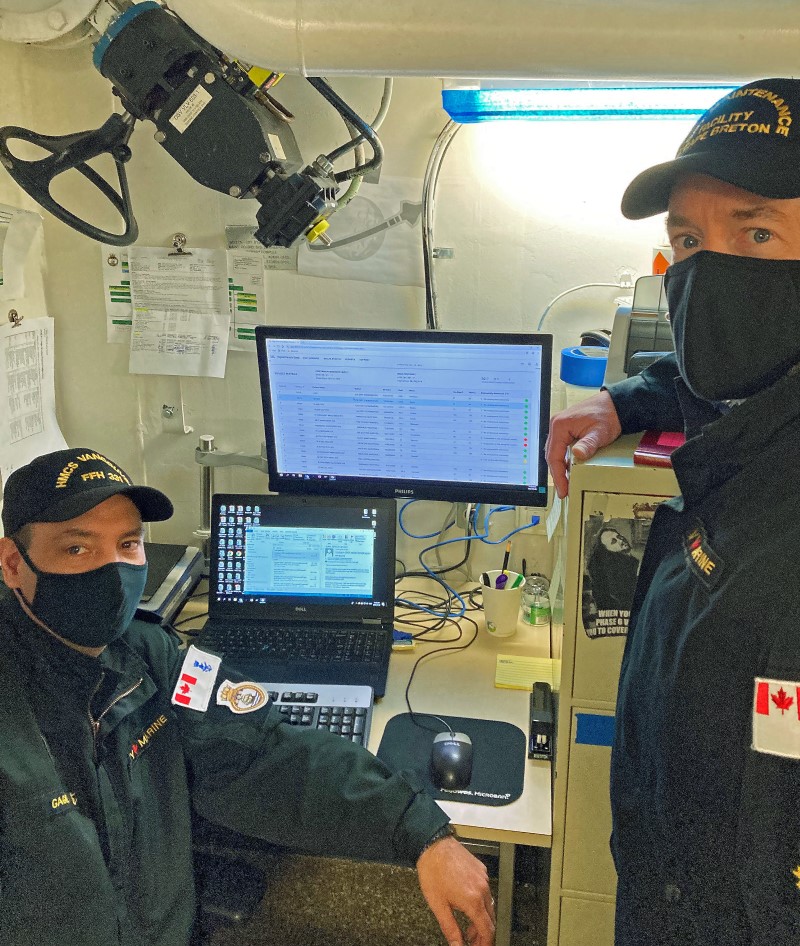Digital Parade State aims to improve personnel management
May 26, 2022 - Royal Canadian Navy
By Peter Mallett

Caption
CPO1 Mike Umbach, a subject matter expert on the Digital Parade State tracking software, demonstrates the program to CPO2 Chris Gagne, HMCS Vancouver’s Combat System Engineering Chief.
Once again the Royal Canadian Navy (RCN) is embracing technology to improve the way it does business.
This spring the RCN launched Digital Parade State, an internally developed tracking software that provides instant, accurate information on crewing needs and personnel availability.
After beta testing, the software went live in February with users in Canadian Fleet Pacific (CANFLTPAC) HQ staff, Her Majesty’s Canadian Ship (HMCS) Regina, and the Personnel Coordination Centre in the initial roll out.
“This application provides our ships and sailors greater insight into the data that affects their day-to-day availability and career progression, and is a boon to personnel management efforts,” says Lt(N) Brent Fisher, Digital Parade State team lead.
“It will help address crewing shortages and improve personnel management by providing a real-time view of billet status and key statistics, and it addresses limited visibility on sailor employability.”
With the Navy currently short more than 1,000 sailors, the software will aid in better addressing personnel challenges, he adds.
“The idea is to digitize business processes and provide a one-stop shop where fleet staffs can get an overview of all ships, who is available to sail and who isn’t,” says Lt(N) Fisher. “It reduces dependency on unaligned personnel shadow systems, last-minute phone calls and voicemail messages, and unofficial Excel spreadsheets to fill personnel needs.”
Lt(N) Fisher notes that the software is still a work in progress. New features will be added to the program each month, and problems with the software will be adjusted and fixed, with user feedback key to its evolution.
Reaction to the new technology has been overwhelmingly positive, says Chief Petty Officer 1st Class (CPO1) Mike Umbach, Maritime Forces Pacific’s Digital Parade State subject matter expert. CPO1 Umbach has been instructing units and ships on how to use the new technology, and members appreciate the ease of use and the efficiency of how information is presented.
“A significant number of individuals have also recognized the value (the software) provides in supporting our members to more efficiently crew our fleet. They see it as an innovative and modernized approach to how the Navy manages personnel,” CPO1 Umbach says.
CPO1 Umbach has 30 years of experience in the Navy serving in numerous warships and shore units. He has worked as a naval electronic technician and weapons engineering manager before being promoted chief petty officer 1st class, and says there is a high demand for simple high-tech solutions such as this.
“Due to ongoing personnel shortages, and the current operational tempo, we need to better manage our members to reduce burnout while maintaining operational effectiveness,” he says.
CPO1 Umbach recently completed training with HMC Ships Regina, Ottawa, Calgary and Vancouver on how to use the software and its future capabilities. In the coming weeks, he will be training Maritime Coastal Defence Vessel and Canadian Submarine Force members, eventually expanding to all shore units within Maritime Forces Pacific. Digital Parade State is being rolled out on the East Coast by Petty Officer 1st Class Kurt Eason.
It will also be important for junior members of the fleet to have a working understanding of the application and start using the program to its full potential.
“They need to be aware of the bigger picture and the reasons behind why some decisions are being made, as the more knowledgeable and informed our junior members are, it will help alleviate some stressors and build trust in the organization,” adds CPO1 Umbach.
The application was developed by a team from Base Information Services and Director Digital Navy starting in the fall of 2021.